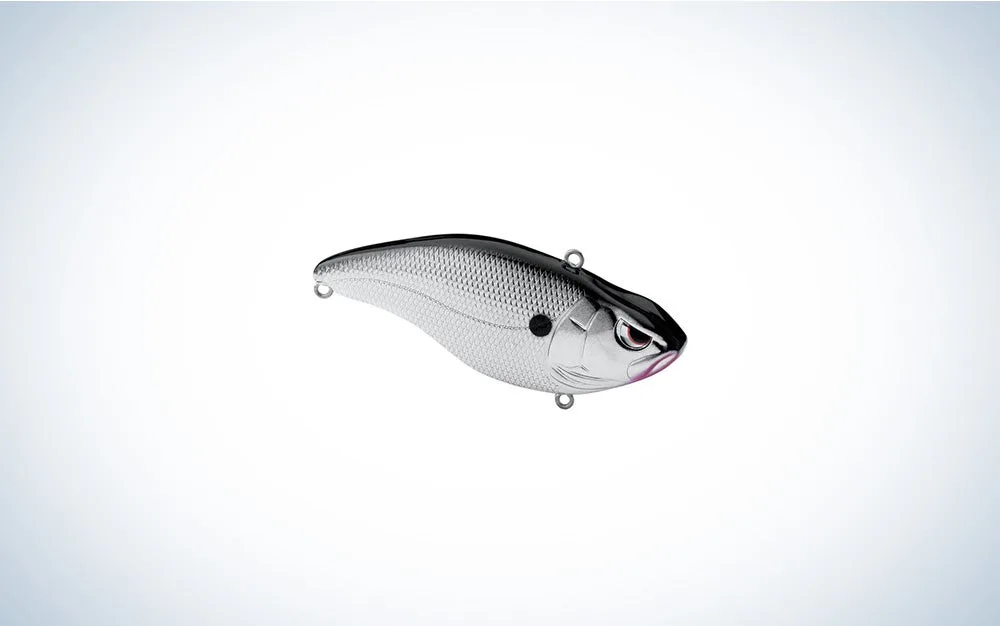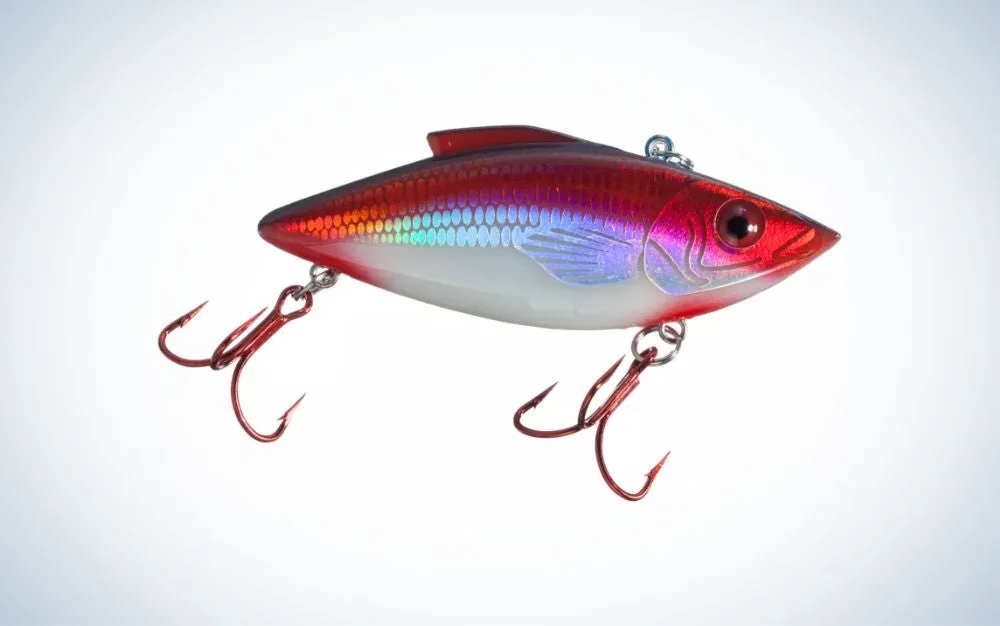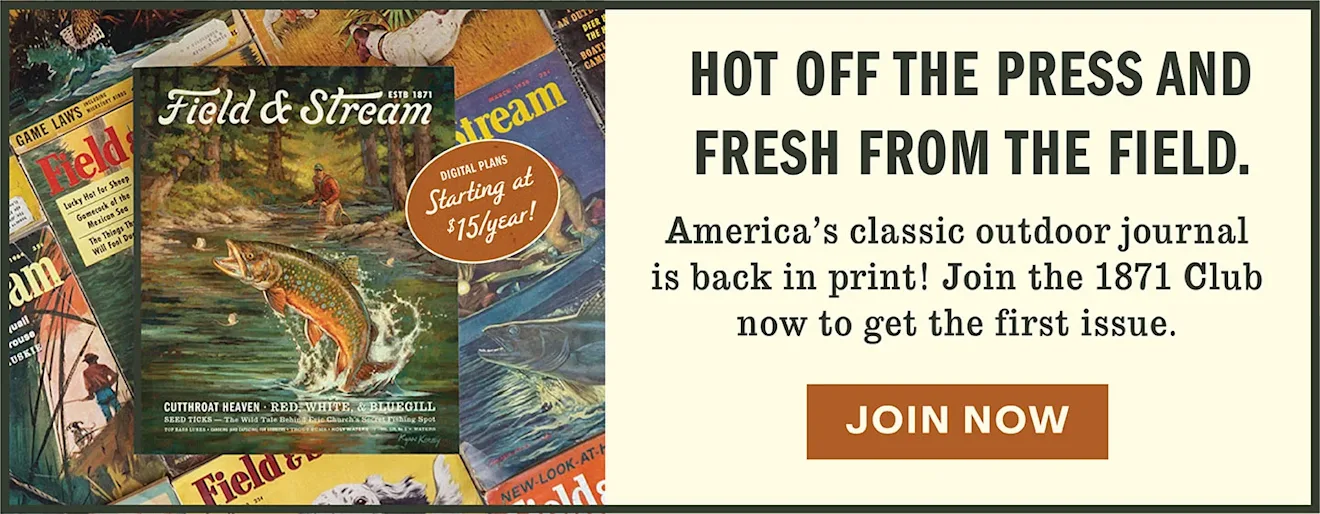_We may earn revenue from the products available on this page and participate in affiliate programs. Learn more ›
_
Best Silent

SPRO Aruku Shad Silent
LEARN MORE
Summary
One of the few silent lipless cranks available to offer flash and shake without the fuss
Best Overall

Booyah Hard Knocker
LEARN MORE
Summary
Top-shelf finishes in a shad profile make this one hard for bass and other game fish to pass up.
Best Budget

Bill Lewis Rat-L-Trap
LEARN MORE
Summary
This tried-and-true performer still owns the lipless market without a painful pinch at the cash register.
Few lures cover the entire water column and draw as much attention as a lean, loudmouthed lipless crankbait. When Cotton Cordell introduced the Hot Spot in 1958, it was an instant hit with anglers looking to chase schooling fish and one of the only crankbaits able to reach deeper than 10 feet. With no diving lip, this sinking crankbait could run at practically any depth by varying the speed of the retrieve. The lack of a bill also helped the lure come through grass cleanly instead of bogging down nose-first in the salad. Aside from the all-important addition of rattles by Rat-L-Trap creator Bill Lewis in the 1960s, relatively little has changed in the makeup of most lipless crankbaits in more than 60 years. But, just like all things angling, little tweaks make big differences when conditions are right. Here are a few of the best lipless crankbaits on the market—modern takes that are sure to stir up a commotion the next time you’re looking to aggravate the fish into taking a bite.
**Best Overall: Booyah Hard Knocker
**
**Best Silent: SPRO Aruku Shad Silent
**
**Best Budget: Bill Lewis Rat-L-Trap
**
Best Overall: Booyah Hard Knocker
Best Overall

Booyah Hard Knocker Booyah
Why it Made the Cut: Top-shelf finishes in a shad profile make this one hard for bass and other game fish to pass up. The top-quality hardware and decent price point mean you’ll have just as hard a time not biting.
Key Features
2 ¼-, 2 ½-, and 3-inch sizes
¼-, ½-, and ¾-oz. weights
Offered in 15 colors
Pro:
Premium Gamakatsu hooks
Enticing flutter-spoon action on the fall
Cons
Not quite as good as its discontinued forerunner
The shad-shaped Booyah Hard Knocker might just be the most versatile lure in my tackle box
. In addition to the fish-stirring commotion it causes when burned over brush or grass, it has a perfect fluttering fall when fished with a lift-and-drop retrieve for fish stationed under balls of shad or other baitfish. The lure is based on PRADCO’s extremely popular, but discontinued, Excalibur XR50 lipless crankbait
. It may not be an exact clone, but it’s as close as you’re going to get to that famous lure without spending upwards of $50 on an auction website. Booyah’s Hard Knocker also is available in a one knocker model, which is available in the same sizes and colors, but features a single large bead in the rattle chamber to give more of a “clack” sound that matches up with that of a crawfish pulsing away with flicks of its tail. Booyah gave anglers the best of both worlds with the hooks, using a larger triple grip-stye hook on the front for positive hooksets and a smaller round-bend on the back that gives you a chance to land short-striking fish.
Best Silent: SPRO Aruku Shad Silent
Best Silent

SPRO Aruku Shad Silent
Why It Made the Cut: The SPRO Aruku is one of the few silent lipless cranks available to offer flash and shake without the fuss.
Key Features:
3 inches
⅝-oz.
Available in seven colors
Pros:
It’s one of the few silent lipless cranks still in production
Premium hardware and finish withstand abuse well
Con:
Lack of options leave an angler wanting
Sometimes the action of a lipless crankbait is on point, but the rattle causes a little too much commotion for fish in clear or pressured waters. Even though the original Cordell Hot Spots were made sans rattle, anglers are hard-pressed to find a good lipless crank that runs in stealth mode lately. The SPRO Aruku Silent is one of the few options currently on the market, and it’s one anglers may want to have handy in case the bite turns sour and the fish want something they haven’t seen before. The shad-shaped profile is similar to many modern rattle baits, and the weight is focused on the front of the lure to keep it nose-down when the lure is burned back to the boat. The lure is outfitted with premium Gamakatsu treble hooks. The combination of a size 4 on the front and size 6 on the rear makes hookups a little easier on those fish that slash at the lure out of instinct when it slides up beside them, but it still comes through grass relatively clean. The only drawback to the Aruku Silent is the lack of variety. If you’re wanting to downsize to a ¼-oz. lure to match young-of-the-year baitfish or move up to a larger size to work deep grasslines, you’re out of luck.
Best Budget: Bill Lewis Rat-L-Trap
Best Budget

Bill Lewis Rat-L-Trap Bass Pro Shop
Why It Made the Cut: This tried-and-true performer still owns the lipless market without a painful pinch at the cash register.
Key Features:
Sizes range from 1 ¾-inches to 4 inches
Available in ⅛-, ¼-, ½-, ¾- 1- and 1 ½-oz. weights
Offered in 112 colors (and counting!)
Pros:
Affordable cost without a loss of performance
Amazing variety to match any fishing condition
Famous “fleeing baitfish” sound profile
Cons:
Hooks could use replacing
Some finishes are easy to chip
It’s hard to improve on the winning formula the folks at Bill Lewis Lures came up with back in the psychedelic ‘60s with the original Rat-L-Trap. With the exception of new colors and some minor upgrades in the hooks, the first lipless crankbait with internal rattles hasn’t changed much, and neither has its price. Despite rising material costs, the original Rat-L-Trap still comes in a few dollars less than some of the flashier new models. Shop around and you might even find it half the price of other rattle baits. But, you won’t be able to tell the difference in performance between the modern Rat-L-Trap and the ’Traps of old. The color and size selection are incredible, with offerings ranging from the ⅛-oz. Tiny Trap to the 1 ½-oz. Magnum Force Trap to fish deep for larger prey and even saltwater species. The only drawback I’ve had in years of chunk-and-wind sessions with Rat-L-Traps is that the factory hooks by Mustad are good, but not quite as nice as some from premium brands. The paint of some color selections, particularly chrome offerings, also can chip and peel after a little abuse from underwater rocks, stumps and the many fish’s faces it’s liable to make contact with.
Things to Consider Before Buying a Lipless Crankbait
Size
Varying sizes of lipless crankbaits enable anglers to “match the hatch” and better mimic local forage. More importantly, it allows anglers to adjust the depth at which they are fishing. If fish are holding deeper, a larger, heavier lipless crankbait will get down there and let you maintain a decent retrieve speed. Likewise, a ¼-oz. lipless crankbait runs shallow and is perfect for capitalizing on fry-guarding bass still in the shallows after the spawn. Some manufacturers even offer an ⅛-oz. size that is bad medicine on finicky bass, bream, crappie and white bass when fished on light-action spinning gear.
Rattle Chamber
Different cranks will produce a different sound, depending upon the size, number and construction of the rattles inside. The original Rat-L-Trap had a magical underwater sound profile eerily similar to a school of panicked shad, but the fish can get conditioned to those vibes. Some manufacturers offer “one-knocker” versions with only one large BB inside to give a different rattle, some use rattles of tungsten for a crisper sound, and others may even forgo the rattles altogether. Having a few of each design lets you offer something different on tough days or after you’ve already caught a few fish and the bite begins to wane.
Hooks
Some fish will slash at the lure as it is passing instead of committing to the strike. Round-bend hooks might increase the chance of an initial hookup on these bites, but the lure’s weight makes it easier to shake free than many lure types. The best lipless crankbaits will have premium hooks that are scary sharp. Standard ½- to ⅝-oz. lipless crankbaits should come with a minimum of size 4 treble hooks to increase hookup ratio and allow for a bit of belly in the hook bend to help keep fish pinned. If you do stick with round-bend hooks, you’ll want one of the best crankbait rods
with a softer tip to give the fish room to fight.
FAQs
Q: What is the best color for a lipless crankbait?
Color selection for lipless crankbaits will vary based on the type of forage you want the lure to represent. In early spring when crayfish begin to emerge from the mud they’ve been buried in all winter, no bass angler would be caught dead without a red lipless crankbait tied to the line. As the year progresses, game fish from bass to walleye will begin to key on shad, so a silver or shad-colored crank will get the nod. On cloudy days, a flashy gold color will draw strikes better than silver. Some anglers swear to using black lipless crankbaits when the water is extremely muddy and the sound rattles them in. The black offers a better silhouette of the target in the dingy water when the color isn’t as critical.
Q: How deep do lipless crankbaits go?
Since they sink, lipless crankbaits will go as deep as the angler has the patience to let them sink. You can burn them in shallow water with a fast retrieve, or you can allow them to drop to 20 and even 30 feet of water and slowly reel them back or work them back with a lift-and-drop technique to trigger a reaction strike. For the most part, anglers tend to pick up a lipless crankbait and retrieve it at a steady pace when trying to elicit a strike in 2- to 12-feet of water.
Q: Can you troll a lipless crankbait?
Yes! Lipless crankbaits are especially deadly on white bass and crappie when trolled behind a boat at slow speeds. Unlike crankbaits featuring diving bills, lipless cranks will run in practically any depth, depending upon the amount of line let out and the speed of the boat. The drawback to trolling lipless cranks, however, is that the angler must spend much more time getting to know the exact speed and distance from the boat for each size lipless crank being pulled.
Final Thoughts
The selections above offer a great starting point to build a box of lipless crankbaits for times when you’re trying to draw a reaction strike, but variety is a key contributor to catching fish better than your buddies when everyone is chasing schooling fish or fishing the same pattern. Just like potato chips, you can never have just one lipless crankbait brand in your arsenal. While I tend to stock up on these three baits and dance with the one I brought to the ball, I’m not afraid to try a new sound when the fish begin to tire of the same old song and dance.
Methodology
In addition to more than three decades of fishing for bass, crappie, catfish and other freshwater sportfish, I have had the opportunity to work with manufacturers and sales representatives of various tackle companies as well as dozens of fishing guides in fishing reports. There’s always been a box of lipless crankbaits in my boat, and these selections are based on personal experience with these lures in a variety of fishing conditions.





